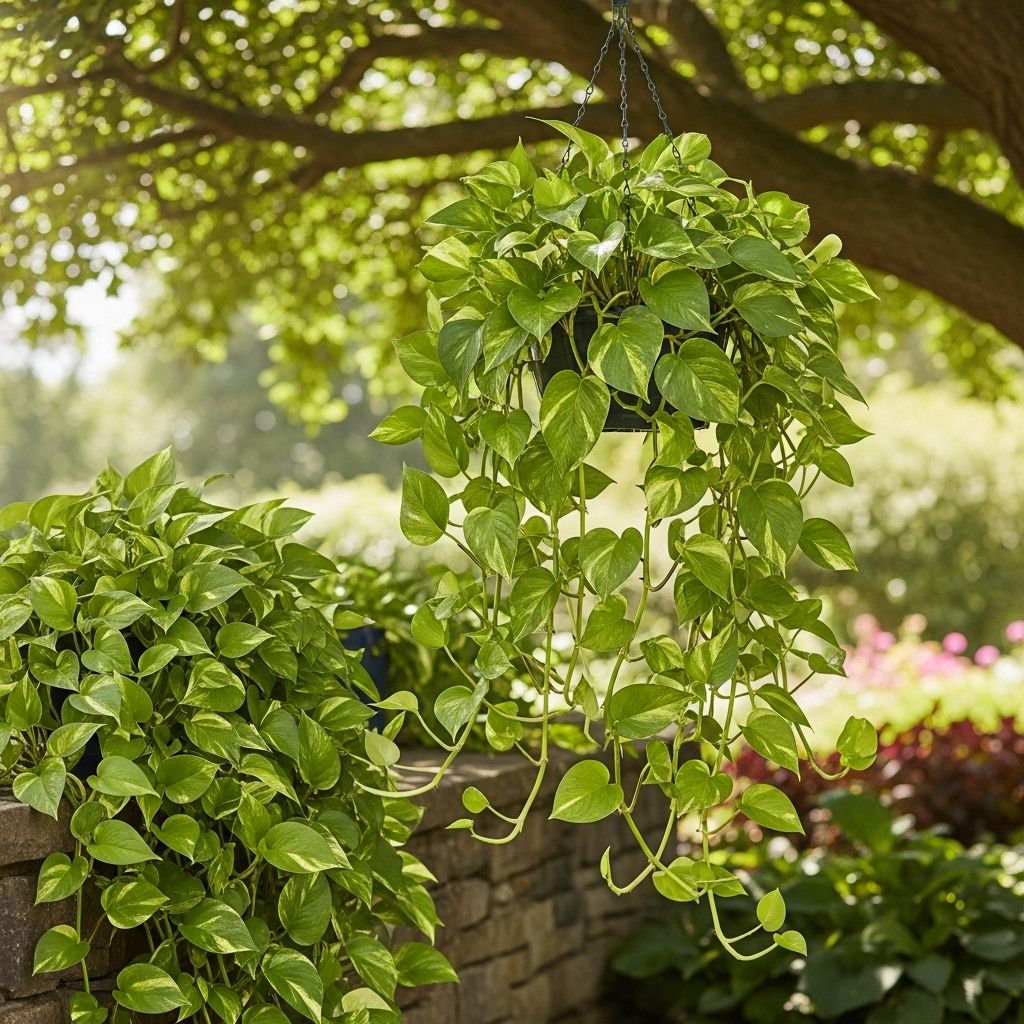Growing Pothos Outdoors: The Complete Guide to Thriving Vines
Master outdoor conditions to keep Devil’s Ivy thriving beyond your indoor pots.

Image: HearthJunction Design Team
Can You Grow Pothos Outdoors?
Pothos (Epipremnum aureum, commonly known as Devil’s Ivy) is a beloved tropical vine praised for its vigorous growth and low-maintenance nature indoors. But many gardeners wonder—can you successfully grow Pothos outside, and under what circumstances will it thrive? The answer depends on your local climate, growing zone, and gardening goals.
Understanding Pothos’ Native Habitat
Pothos hails from tropical regions of Southeast Asia and the South Pacific. In its native environment, it’s a climbing or sprawling vine that can reach up to 60 feet in length outdoors. The lush, trailing foliage that makes it a favorite for indoor settings can be even more pronounced when grown outside, but it comes with important considerations for climate, care, and containment.
What Outdoor Conditions Does Pothos Require?
Pothos is only truly hardy in USDA zones 10–12. In these frost-free climates, pothos can be grown year-round as a perennial evergreen vine, just as it thrives in its native tropical forests. In cooler regions, it should be treated as a summer annual, greenhouse plant, or kept in containers that move indoors during the colder months.
| USDA Hardiness Zone | Outdoor Potential | Notes |
|---|---|---|
| 10–12 | Perennial, evergreen outdoors | Grows rapidly if kept moist and shaded |
| 8–9 | Annual or overwinter inside | Dies back in frost; container growing recommended |
| Below 8 | Potted summer plant only | Move indoors before first frost |
Annual Versus Perennial Growing
- Zones 10–12: Grow pothos directly in the ground or in large planters. It can climb, spread, and flourish all year.
- Zones 8–9: Keep pothos in containers or treat as an annual in garden beds. Move plants indoors or to a protected area before temperatures drop below 50°F (10°C).
- Zones 7 and below: Only grow pothos outside during the summer months in pots, patios, or hanging baskets, then relocate inside for winter.
How to Move Indoor Pothos Outside
If you live in a colder region but want to enjoy lush outdoor foliage during the warm months, the solution is to move your pothos outside in containers once nighttime temperatures remain steadily above 55°F (13°C). This practice allows gardeners in almost any climate to enjoy pothos outdoors each summer while protecting them from cold damage.
- Gradually acclimate (harden off) your pothos by moving it outside for a few hours daily, increasing exposure over a week.
- Choose a shaded to partially shaded location protected from midday sun and wind.
- Monitor for shock; reduce watering until active growth resumes.
Where to Plant Pothos Outdoors
In warm climates, pothos is extremely versatile in the landscape. You can:
- Let it sprawl on the ground as a groundcover—ideal for filling large, shady areas.
- Train it to climb trees, fences, or trellises for a lush, tropical effect.
- Grow it in large containers or hanging baskets for portability and easier management.
- Let vines cascade over retaining walls or balcony rails.
Lighting Requirements
Pothos prefers dappled or indirect light outdoors, similar to the understory conditions of a tropical forest. Bright, filtered shade is best. Too much direct sun can scorch leaves, especially strong afternoon rays. Morning sun or all-day shade beneath trees is ideal.
Soil Preferences
Pothos is tolerant of many soil types but thrives in well-draining, moderately fertile soil with consistent moisture. It can adapt to soils ranging from acidic to slightly alkaline and even tolerates short periods of wet feet. However, soggy, poorly drained soil may cause rot.
- You can plant directly in garden beds, or use a potting mix for containers.
- Amend heavy clay soils with compost or bark fines to improve drainage.
Planting and Spacing Tips
For the fullest coverage:
- Space pothos plants 18–24 inches apart for groundcover.
- For vertical growth, plant at bases of trees, sturdy trellises, or fences, allowing vines to climb.
- Use larger pots (12 inches or more in diameter) for substantial growth in containers.
Planting Steps
- Prepare the site by loosening soil or filling containers with quality potting mix.
- Dig a hole as deep and twice as wide as the root ball.
- Set the plant at the same depth it was in its nursery pot.
- Backfill, water thoroughly, and mulch lightly to retain moisture.
Caring for Outdoor Pothos
Watering
Pothos is relatively drought-tolerant once established, but enjoys regular deep watering during periods of growth. Allow the soil to dry slightly between waterings; avoid waterlogging. In winter or cooler conditions, reduce watering frequency.
Fertilizing
- Fertilize lightly with a balanced, slow-release fertilizer in spring and midsummer.
- Container plants benefit from monthly applications of diluted liquid fertilizer during the growing season.
Pruning and Maintenance
- Trim vines regularly to encourage bushier growth and limit spread.
- Remove dead or yellowing leaves as needed.
- Wear gloves when pruning—pothos sap can be mildly irritating to sensitive skin.
- For large vines, train or tie stems to supports as desired.
Managing Invasiveness and Wildlife Impact
Pothos is considered invasive in some regions (notably southern Florida, Hawaii, and some Pacific islands), where it can outcompete native vegetation and disrupt habitats. Always check with local extension services before planting outdoors in warm climates. If invasiveness is a concern, stick to container cultivation and be diligent about removing cuttings and vines to prevent wild escape.
Common Outdoor Pothos Challenges
- Frost Damage: Pothos is highly sensitive to cold. A single night of frost can kill leaves and stems. Always bring container plants indoors before the first frost.
- Sunburn: Scorched, bleached leaves indicate too much direct sunlight. Move plants to shadier spots or provide shelter from midday sun.
- Pests: Snails, slugs, and occasionally spider mites or aphids may feed on outdoor pothos. Use non-toxic controls if needed.
- Root Rot: Occurs in soggy soils. Ensure drainage and avoid overwatering.
Pothos Varieties for the Outdoor Garden
Several stunning cultivars are available, each well-suited for outdoor containers or shady borders:
- Golden Pothos (E. aureum): Classic chartreuse-and-emerald leaves, highly adaptable.
- Marble Queen: Creamy-white variegation, slower-growing but striking in landscape plantings.
- Neon Pothos: Bright lime-green leaves, adds a pop of color in deep shade.
- Jade Pothos: Dark green leaves, more tolerant of low-light and cooler temps.
Design Ideas for Outdoor Pothos
- Hanging Baskets: Overflowing vines create lush curtains for patios and porches.
- Living Fences: Train pothos along trellis panels for a tropical privacy screen.
- Tree Underplanting: Let pothos sprawl beneath palms or shade trees for a layered woodland effect.
- Mixed Containers: Combine with ferns, caladiums, and begonias for a vibrant shade planter.
Seasonal Care and Overwintering
In climates with cool winters, overwinter potted pothos indoors before temperatures dip below 50°F (10°C). Prune as needed, check for pests, and reduce water and fertilizer while indoors. Return to the garden when all frost danger has passed.
FAQs: Growing and Caring for Pothos Outdoors
Q: Will pothos survive winter outdoors?
A: Pothos will only survive winter outdoors in frost-free, tropical or subtropical climates (USDA zones 10–12). In colder regions, it must be brought indoors or will die back to the roots, if not completely killed by frost.
Q: Can pothos be invasive outdoors?
A: Yes, in some warm, humid regions pothos can become invasive, spreading aggressively and smothering native plants. Always check with your local extension office before planting outdoors, and consider container growing to limit spread.
Q: How often should I water outdoor pothos?
A: Water deeply when the surface soil becomes dry, adjusting frequency for weather conditions. Pothos prefers consistent moisture but tolerates short droughts once established. Do not let the soil stay soggy.
Q: What’s the best fertilizer for outdoor pothos?
A: Use a slow-release balanced fertilizer at the start of spring and midsummer. Monthly liquid feedings benefit container plants during the peak growing season.
Q: Can I grow pothos as a groundcover?
A: Absolutely! In shade gardens in the proper climate, pothos grows vigorously as a groundcover, filling in bare spots and suppressing weeds.
Conclusion
With the right climate and a bit of planning, pothos can become a resilient, spectacular addition to outdoor gardens. Whether spilling from baskets or climbing up trees, its adaptable nature and bold foliage bring a tropical flair to shade gardens and patios. For gardeners in colder zones, container growing offers the joy of lush vines all summer with easy overwintering indoors. Always check for invasiveness in your region, and enjoy the vibrant versatility of outdoor pothos!
References
Read full bio of medha deb












